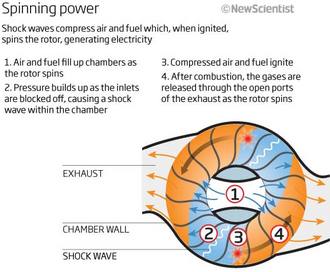Shockwave-Generating Wave Discs Could Replace Internal Combustion Engines | Popular Science
Michigan researchers have built a prototype of a new auto motor that does away with pistons, crankshafts and valves, replacing the old internal combustion engine with a disc-shaped shock wave generator. It could slash the weight of hybrid cars and reduce auto emissions by 90 percent.
[...]
The novel generator would use about 60 percent of fuel for propulsion, according to MSU. This is a dramatic improvement over typical car engines, which use only 15 percent of fuel for forward movement. The system could also make cars 20 percent lighter, improving fuel economy even more.
Collected from: Shockwave-Generating Wave Discs Could Replace Internal Combustion Engines | Popular Science
Shock wave engines could triple fuel efficiency in hybrid cars | DVICE
A wave disk engine is essentially just a disk with a bunch of channels cut into it that spins around super fast. The center is hollow, and portions of the inside and outside edges of the rotor are alternately sealed off and opened up as it rotates. As shock waves from the rotation compress and ignite fuel in the channels, the rotor spins, and if you hook the back end of it up to a generator, you get electricity.
Confused? No problem, here's a helpful diagram from New Scientist:
Wave disk engines to make hybrid vehicles cheaper, more efficient | ZDNet
How do wave rotor engines work?
The wave disk engine is a new implementation of wave rotor technology (think micro turbines). The first successful realization of a wave rotor was developed in the mid-1950s.
Wave rotors (also called pressure wave machines or pressure exchangers) are unsteady-flow devices that utilize shock waves to transfer energy directly between a high-energy fluid to a low-energy fluid, thereby increasing both temperature and pressure of the low-energy fluid.
[...]
The wave disc technology, however, uses a radial and circumferential flow, which can substantially improve the scavenging process by using centrifugal forces. Compared with straight channels, curved channels provide a greater length for the same disc diameter, which can be important to obtain certain wave travel times for tuning. (Another paper, published in December 2008, explores this topic in detail.)
Collected from: YouTube - Norbert Mueller describes his wave disk generator
Related


